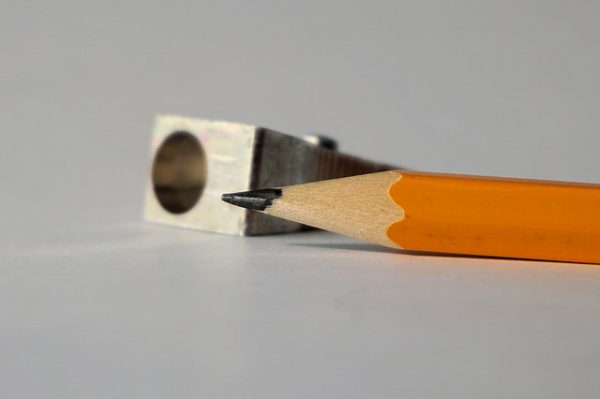
Most people taking the GRE sit for the computer GRE. But did you know there’s also a GRE paper test? Offered in locations where the computer GRE is unavailable, the paper-based GRE is a physical version of the computer GRE. Aside from format, though, are the two tests really all that different?
Read on to explore everything you need to know about the GRE paper test, including what it is, who takes it, and when it’s administered. We’ll also conduct a brief GRE paper vs computer comparison and give you advice on how to study effectively for the paper-based GRE.
What Is the GRE Paper Test?
A hard copy version of the computer GRE, the GRE paper test is administered at select paper-delivered test centers in areas where the computer GRE is unavailable. (You may also be able to take the paper-based GRE if you’ve received approval for special testing conditions.)
This means you can’t opt for the GRE paper test over the computer GRE simply because you want to. Ultimately, what version of the GRE you take — paper or computer — depends entirely on where you take the exam.
Many areas administer the paper-based GRE instead of the computer GRE, including U.S. territories Puerto Rico and American Samoa, as well as select cities in Canada, Brazil, Russia, and South Africa. For an exhaustive list of paper-delivered test locations, refer to the official GRE test center PDF.
So, who actually takes the GRE paper test? And will you have to take it, too?
Quick side note: we've created the world's leading online GRE prep program that adapts to you and your strengths and weaknesses. Not sure what to study? Confused by how to improve your score? We give you minute by minute guide.
You don't NEED a prep program to get a great GRE score. But we believe PrepScholar is the best GRE prep program available right now, especially if you find it hard to organize your study schedule and don't know what to study.
Click here to learn how you can improve your GRE score by 7 points, guaranteed.
Who Takes the GRE Paper Test?
Before we proceed, allow me to clarify something: the GRE paper test is far less common than the computer GRE. In fact, the vast majority of test takers take the computer GRE.
According to 2016 ETS data, 98 percent of test takers took the computer GRE. This means a mere 2 percent took the paper version of the exam! So if you’re gearing up for GRE registration, chances are you’ll be taking the computer GRE, not the paper GRE.
But how can you know for certain which version you’ll take? One way to check is to log on to your ETS Account and follow the GRE registration process for your city. Each available test time will contain an indication telling you what kind of test it is (i.e., paper or computer).
Another method is to look for your city on the official GRE test center PDF. Don’t just assume that if you find your country you’ll for sure take the paper version of the exam. In some countries, the paper-based GRE is offered only in select cities — meaning, the computer GRE might be available in other cities not listed on the PDF. Therefore, we recommend searching for your exact city (or whatever the closest major city to you is).
But how alike (and how different) are the two versions of the GRE anyway?

GRE Paper vs Computer: How Do the Two Versions Differ?
For the most part, the GRE paper test is extremely similar to the computer GRE. Both exams use the same scoring scales and comprise the same three GRE sections: Verbal Reasoning, Quantitative Reasoning, and Analytical Writing (AW). These sections contain all of the same types of questions. (The only major difference is that the GRE paper test doesn’t include any Reading Comprehension questions wherein you must select a sentence from a passage.)
Additionally, the overall logistics are the same for both versions of the GRE. To register for either the paper GRE or the computer GRE, log on to your ETS Account; choose a test center, date, and time; and pay the $205 exam fee.
But not everything about the exams is identical. The following table provides a brief GRE paper vs computer comparison:
| Paper GRE | Computer GRE | |
| # of Sections | One AW, two Verbal, two Quant | One AW, two Verbal, two Quant, one unscored experimental or research section* |
| # of Questions | AW: two essays Verbal: 25 questions per section Quant: 25 questions per section |
AW: two essays Verbal: 20 questions per section Quant: 20 questions per section |
| Time | AW: 30 mins per essay Verbal: 35 mins per section Quant: 40 mins per section |
AW: 30 mins per essay Verbal: 30 mins per section Quant: 35 mins per section |
| Section Adaptive? | No | Yes |
| Calculator? | Yes, a physical calculator provided by the test center | Yes, an on-screen calculator |
| Scratch Paper? | No, but you may use your test booklet to take notes | Yes, usually 3-6 sheets (you may request more if needed) |
| AW Essay Grader | Two human graders | One human grader and one e-rater |
| Scores | No unofficial scores; official scores are available online five weeks after test day | Unofficial Verbal and Quant scores are available immediately after test; official scores are available online 10-15 days after test day |
| Availability | Up to three times a year in October, November, and February | Multiple times a week year-round |
*On the computer GRE, you will be given an additional Verbal or Quant section (unscored) in the form of either an unidentified experimental section or an identified research section.
As you can see from the table above, there are several notable differences between the GRE paper test and the computer GRE in regard to exam structure.
The paper-based GRE contains five additional questions per Verbal and Quant section, as well as five additional minutes per section (to account for the increase in questions). Furthermore, the paper-based GRE is not section adaptive like the computer GRE is.
Other major exam differences include how soon you receive your scores — GRE paper-test scores take considerably longer to process — and how often each version of the test is administered, which I explain more below.

When Can You Take the GRE Paper Test?
Unlike the computer GRE, which is available nearly every day year-round, the GRE paper test is only available up to three times a year in October, November, and February. This means some test centers will administer the paper-based GRE all three times and others only once or twice. Therefore, don’t assume your test center will administer the GRE paper test three times — it might actually only do so once!
For a full list of 2017-18 paper-test dates, go to the ETS website or check out our guide to all upcoming GRE test dates.
Every testing year, ETS publishes an official list of paper-delivered test centers, which you can use to check how many times your city plans to administer the paper-based GRE. (Note that not all years are the same. Just because one test center administers the paper-based GRE in February one year doesn’t mean it’ll necessarily administer the exam the same time the following year.)
Let’s say the test center closest to you administers the GRE paper test three times a year. In this case, which month should you take the test? Generally, we recommend choosing a test date at least two to three months away so you can ensure you’ll have ample time to study for the GRE and hone your test-taking skills.
But this rule is somewhat vague. To figure out when you specifically should take the GRE paper test, consider the following three factors:
- Your grad school application deadlines
- How much time you plan to dedicate to studying (or by how many points you want to improve your baseline GRE scores in order to hit your goal scores)
- Whether you are open to retaking the GRE, should you prefer higher scores
Let’s look at an example. Laura is an aspiring grad student who will be taking the paper-based GRE. In August she begins looking at possible paper-delivered test dates. Because her grad school deadlines are all in January, she knows right away the February GRE date is a no-go. Additionally, she is OK with retaking the GRE, as all of her schools expect high GRE scores that’ll likely be difficult for her to hit on her first try.
In the end, Laura chooses the October test date. This date guarantees her GRE scores will reach all of her grad programs by their respective deadlines. And if she’s for any reason dissatisfied with her GRE performance, she can go ahead and register for the November test, too. (Note that official GRE paper-test scores take approximately five weeks to process, so it’s extremely possible Laura will wind up retaking the GRE in November before receiving her official October scores.)
Ultimately, the decision of when to take the GRE paper test is yours and yours alone. However, as a general rule, always give yourself ample time to study (two to three months should suffice), and always give your schools enough time to process your GRE scores. For more tips on how to create a foolproof GRE study plan, check out our step-by-step guide.

How to Study for the GRE Paper Test
The truth is, studying for the GRE paper test is really no different from studying for the computer GRE. Most test-taking strategies apply to both versions of the test, and because their content is nearly identical, you can use almost all of the same resources and study materials for the paper and computer GREs.
That said, the format of the GRE paper test differs significantly from that of the computer GRE, so your best bet is to prioritize paper GRE study materials over any computerized materials. Recommended resources include well-reviewed GRE prep books and high-quality paper practice tests.
Normally, we advise test takers to obtain their baseline GRE scores using one of the two ETS PowerPrep tests; however, paper-test takers should instead work with the two official GRE paper practice tests. These free full-length tests (linked below) are official replicas of the GRE paper test, thereby offering paper-test takers a highly realistic testing experience in regard to both GRE form and content.
You can access the two GRE practice test PDFs at the following links:
- Old GRE Practice Test (2009-May 2012)
- Current GRE Practice Test (June 2012-present)
On a related note, there’s no need to completely avoid the PowerPrep tests — these are excellent resources for additional practice questions! The only drawback is that there’s significant overlap between the PowerPrep tests and the practice test PDFs, so you can’t really use the PowerPrep tests as separate full-length tests.
Key Takeaways for the GRE Paper Test
The paper GRE is a physical version of the computer GRE, administered only in areas where the computer GRE is unavailable.
Want to improve your GRE score by 7 points? We have the industry's leading GRE prep program. Built by world-class instructors with 99th percentile GRE scores, the program learns your strengths and weaknesses through machine learning data science, then customizes your prep program to you so you get the most effective prep possible.
Try our 5-day full access trial for free:
While most test takers take the computer GRE, it’s important you figure out ahead of time which version of the GRE you’ll have to take, so you can prepare efficiently. To do so, log on to your ETS Account and search for GRE test sessions in your city. Alternatively, you can look for your city or nearest test center on the official list of paper-delivered test centers.
The paper GRE and computer GRE are extremely similar tests with the same overarching structure, content, and scoring scales; however, the paper-based GRE contains more questions and a little extra time for each Verbal and Quant section. The paper-based GRE also requires a longer waiting period (five weeks) for official GRE scores.
In terms of availability, the paper-based GRE is only administered up to three times a year. If you’re struggling to decide when you should take the exam, be sure to consider your grad school deadlines, your GRE goal scores, and how open you are to retaking it.
Also, don’t worry about trying to secure paper-test study materials. In general, studying for the GRE paper test isn’t all that different from studying for the computer GRE. Any materials geared toward the GRE will likely apply to either version of the test. Our only piece of advice is to prioritize paper study materials over computerized materials, especially when it comes to GRE practice tests.
Ultimately, it doesn’t matter what version of the GRE you’re taking — just that you’re prepared, confident, and ready to get the scores you need!
What’s Next?
Need to register for the paper GRE or the computer GRE? Read our step-by-step guide to GRE registration to get all of the help you need with creating an ETS Account and choosing the best test date for you!
Want to make changes to your GRE registration? Follow our guides to learn how to reschedule your GRE date and how to cancel a GRE test.
Looking for GRE tips and resources? Check out our complete collection of GRE practice tests, our 34 essential GRE tips, and our picks for the top GRE study materials.
Ready to improve your GRE score by 7 points?
We've written a eBook about the top 5 strategies you must be using to have a shot at improving your GRE score.
Download it for free now:

